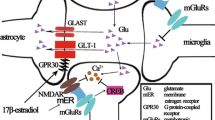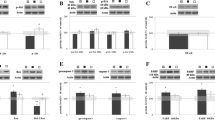Abstract
Estrogen has demonstrated a neuroprotective role in a rat model of glutamate excitotoxicity and other neurodegenerative disorders. We studied the effect of 17β-estradiol on glutamate-induced increases in amino acids levels (aspartate, histidine, taurine and GABA) in the rat cortex. Local perfusion of glutamate produced a transient increase of aspartate, histidine, taurine and GABA in the extracellular fluid. Pretreatment with 17β-estradiol significantly reduced the increases of taurine and moderately attenuated that of histidine, whereas aspartate and GABA releases were not modified. The effect of 17β-estradiol on histidine release was reversed by the antiestrogen tamoxifen, suggesting a receptor-dependent mechanism. Good correlations between the volumes of the glutamate-induced lesions and the extracellular concentrations of taurine and aspartate were observed. These findings suggest that the attenuation of the glutamate-induced release of taurine by 17β-estradiol may participate in the neuroprotective effects of 17β-estradiol and that increased levels of aspartate and taurine are markers for the severity of the glutamate-induced cortical lesions.
Similar content being viewed by others
REFERENCES
Phillis, J. W. and O'Regan, M. H. 1996. Mechanisms of glutamate and aspartate release in the ischemic rat cerebral cortex. Brain Res. 730:150–164.
Benveniste, H., Drejer, J., Schousboe, A., and Diemer, N. H. 1984. Elevation of the extracellular concentrations of glutamate and aspartate in rat hippocampus during transient cerebral ischemia monitored by intracerebral microdialysis. J. Neurochem. 43:1369–1374.
Lipton, S. A. and Rosenberg, P. A. 1994. Excitatory amino acids as a final common pathway for neurologic disorders. N. Engl. J. Med. 330:613–622.
Choi, D. W. 1988. Glutamate neurotoxicity and diseases of the nervous system. Neuron 1:623–634.
Kubo, T., Yokoi, T., Hagiwara, Y., Fukumori, R., Goshima, Y., and Misu, Y. 2001. Characteristics of protective effects of NMDA antagonist and calcium channel antagonist on ischemic calcium accumulation in rat hippocampal CA1 region. Brain Res. Bull. 54:413–419.
O'Neill, M. J., Bogaert, L., Hicks, C. A., Bond, A., Ward, M. A., Ebinger, G., Ornstein, P. L., Michotte, Y., and Lodge, D. 2000. LY377770, a novel iGlu5 kainate receptor antagonist with neuroprotective effects in global and focal cerebral ischaemia. Neuropharmacology 39:1575–1588.
Rao, A. M., Hatcher, J. F., and Dempsey, R. J. 2000. Neuroprotection by group I metabotropic glutamate receptor antagonists in forebrain ischemia of gerbil. Neurosci. Lett. 293:1–4.
Bruno, V., Battaglia, G., Kingston, A., O'Neill, M. J., Catania, M. V., Di Grezia, R., and Nicoletti, F. 1999. Neuroprotective activity of the potent and selective mGlu1a metabotropic glutamate receptor antagonist, (1)-2–methyl-4 carboxyphenylglycine (LY367385): comparison with LY357366, a broader spectrum antagonist with equal affinity for mGlu1a and mGlu5 receptors. Neuropharmacology 38:199–207.
Lees, K. R. 1997. Cerestat and other NMDA antagonists in ischemic stroke. Neurology 49:S66–69.
Mendelowitsch, A., Ritz, M., Ros, J., Langemann, H., and Gratzl, O. 2001. 17β-Estradiol reduces cortical lesion size in the glutamate excitotoxicity model by enhancing extracellular lactate: a new neuroprotective pathway. Brain Res. 901:230–236.
Pellerin, L., Pellegri, G., Martin, J. L., and Magistretti, P. J. 1998. Expression of monocarboxylate transporter mRNAs in mouse brain: support for a distinct role of lactate as an energy substrate for the neonatal vs. adult brain. Proc. Natl. Acad. Sci. USA 95:3990–3995.
Chen, J., Xu, W., and Jiang, H. 2001. 17 beta-estradiol protects neurons from ischemic damage and attenuates accumulation of extracellular excitatory amino acids. Anesth. Analg. 92:1520–1523.
Phillis, J. W., Song, D., and O'Regan, M. H. 1999. Effects of hyperosmolarity and ion substitutions on amino acid efflux from the ischemic rat cerebral cortex. Brain Res. 828:1–11.
Saransaari, P. and Oja, S. S. 2000. Taurine and neural cell damage. Amino Acids 19:509–526.
Saransaari, P. and Oja, S. S. 2000. Involvement of metabotropic glutamate receptors in ischemia-induced taurine release in the developing and adult hippocampus. Neurochem. Res. 25:1067–1072.
De Micheli, E., Pinna, G., Alfieri, A., Caramia, G., Bianchi, L., Colivicchi, M. A., Della Corte, L., and Bricolo, A. 2000. Postoperative monitoring of cortical taurine in patients with subarachnoid hemorrhage: a microdialysis study. Adv. Exp. Med. Biol. 483:595–603.
Moore, F. L. and Evans, S. J. 1999. Steroid hormones use non-genomic mechanisms to control brain functions and behaviors: a review of evidence. Brain Behav. Evol. 54:41–50.
Obata, T., Aomine, M., and Yamanaka, Y. 1999. Protective effect of histidine on hydroxyl radical generation induced by potassium-depolarization in rat myocardium. Jpn. J. Pharmacol. 80:217–222.
Matsuyama, S., Nei, K., and Tanaka, C. 1997. Regulation of GABA release via NMDA and 5–HT1A receptors in guinea pig dentate gyrus. Brain Res. 761:105–112.
Butcher, S. P., Bullock, R., Graham, D. I., and McCulloch, J. 1990. Correlation between amino acid release and neuropathologic outcome in rat brain following middle cerebral artery occlusion. Stroke 21:1727–1733.
Staub, F., Graf, R., Gabel, P., Kochling, M., Klug, N., and Heiss, W. D. 2000. Multiple interstitial substances measured by microdialysis in patients with subarachnoid hemorrhage. Neurosurgery 47:1106–1115.
Author information
Authors and Affiliations
Rights and permissions
About this article
Cite this article
Ritz, MF., Schmidt, P. & Mendelowitsch, A. 17β-Estradiol Effect on the Extracellular Concentration of Amino Acids in the Glutamate Excitotoxicity Model in the Rat. Neurochem Res 27, 1677–1683 (2002). https://doi.org/10.1023/A:1021695213099
Issue Date:
DOI: https://doi.org/10.1023/A:1021695213099




